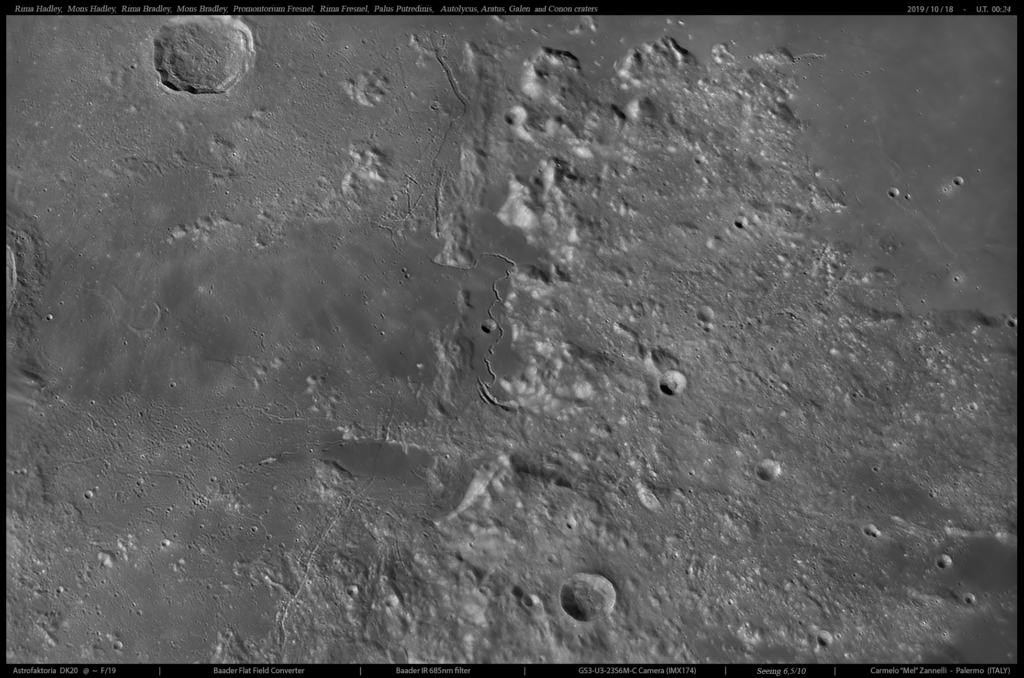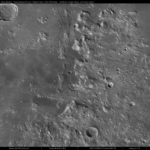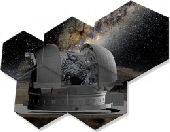Ecco un’altra immagine ad alta illuminazione solare, centrata sulla Rima Hadley e la parte centrale degli Appenini Lunari.
La Rima Hadley è servita come punto di riferimento (sul lato nord di essa) per lo sbarco della navicella Apollo 15, il quarto atterraggio con equipaggio sulla Luna, nel luglio 1971. Il sito si trova sul bordo orientale del Mare Imbrium su una pianura lavica chiamata “Palus Putredinis”.
I dati ottenuti dai campioni di terreno raccolti dalla missione Apollo 15 mostrano che la maggior parte (circa il 90%) dei campioni dal fronte appenninico sono rocce sedimentarie di vetro marrone mentre il 60-70% del campione, proveniente dal mare lavico, è costituito da basalto. Sebbene i basalti sembravano variare nella loro consistenza, le loro età erano pressoché identiche.
L’origine della Rima Hadley ha due ipotesi, la prima delle quali suggerisce che essa sia stata una presa d’aria vulcanica (uno sfogo lavico) tra flussi di lava che ne hanno creato le caratteristiche e la forma; la seconda ipotesi, invece, suggerisce più semplicemente che la rima fosse originariamente un normale canale sinuoso di lava tra la Palus Putredinis e gli Appennini Lunari. Essa ha una profondità compresa tra 180 e 270 m., con picchi di circa 370 m. vicino al sito di atterraggio dell’Apollo 15, con angoli di inclinazione (verso il basso) di circa 25°.
Gli Appennini lunari, invece, hanno una altezza di quasi ben 5 km. dal fondo lavico sottostante e l’area delle montagne appenniniche tra Mons Hadley e Silver Spur (una montagna a sud-est di Mons Hadley Delta), sebbene priva di una designazione ufficiale sulle mappe e altra letteratura ufficiale della missione, è stata informalmente definita “Swann Range” dagli astronauti dell’Apollo 15 (David Scott e James Irwin), in onore dell’allora leader del team di geologia della missione Apollo 15, Gordon Swann.
Grazie per la vostra attenzione!
Dettagli tecnici:
Telescopio Astrofaktoria DK20 @ ~ F/17 – Baader FFC Multiplier – Baader IR 685nm filter – GS3-U323S6M-C camera – Seeing 6,5/10 in IR band – sito: Palermo @ my personal Observatory.
English:
Rima Hadley served as a reference point (on the north side of it) for the landing site of the Apollo 15 LEM, the fourth landing on the Moon, in July 1971. The site is located on the eastern edge of the Imbrium Sea on a lava plain called “Palus Putredinis”.
The data obtained from the soil samples collected by the Apollo 15 mission show that most (about 90%) of the samples from the Apennine front are sedimentary rocks of brown glass while 60-70% of the sample, coming from the lava floor, is constituted from basalt. Although the basalts seemed to vary in their consistency, their ages were almost identical.
The origin of Rima Hadley has two hypotheses, the first of which suggests that it was a volcanic site intake (a lava leak) between lava flows that created its features and shape; the second hypothesis, suggests instead simply that the rille was originally a normal sinuous lava channel between the Palus Putredinis and the Lunar Apennines. It has a depth between 180 and 270 m, with peaks of about 370 m. near the landing site of the Apollo 15, with inclination angles (downwards) of about 25°.
The lunar Apennines, on the other hand, have a height of almost 5 km. from the underlying lava floor and the area of ??the Apennine mountains between Mons Hadley and Silver Spur (a mountain south-east of Mons Hadley Delta), it has been informally defined “Swann Range” by Apollo 15 astronauts David Scott and James Irwin, in honor of the leader of the geology team of the Apollo 15 mission, Gordon Swann.
Thank you for your attention!
Technical details:
Astrofaktoria Telescope DK20 @ ~ F / 17 – Baader FFC Multiplier – Baader IR 685nm filter – GS3-U323S6M-C camera – Seeing 6,5/10 in IR band – site: Palermo @ my personal Observatory.


